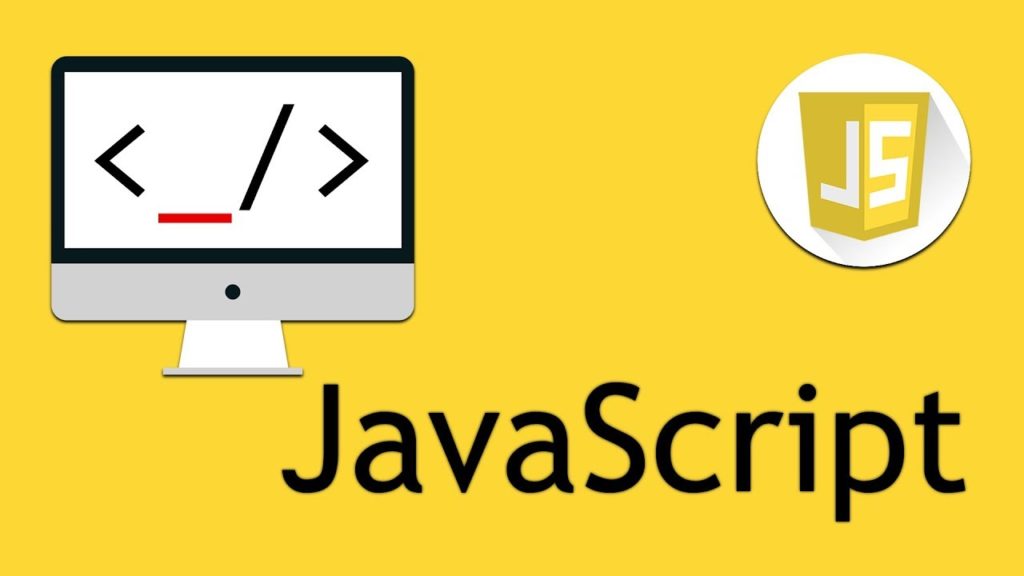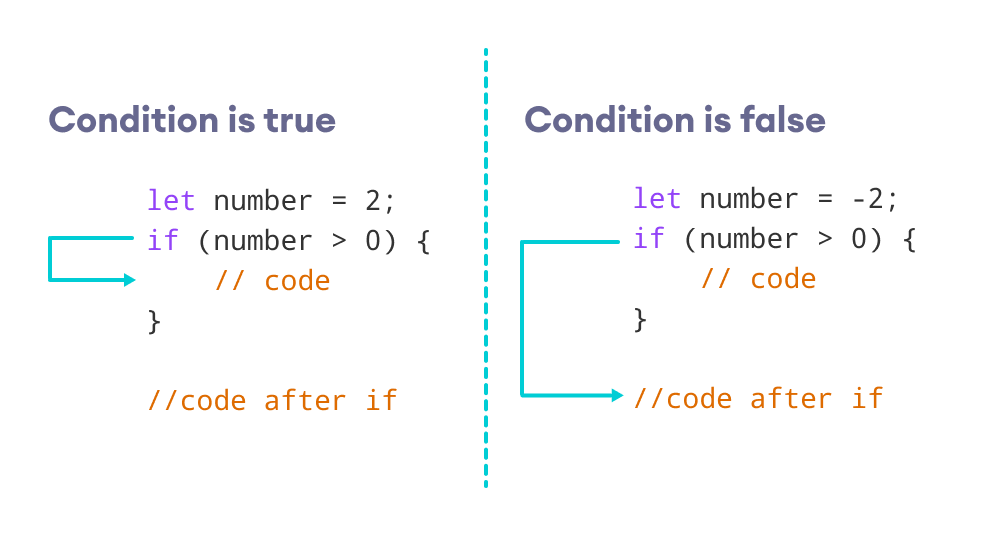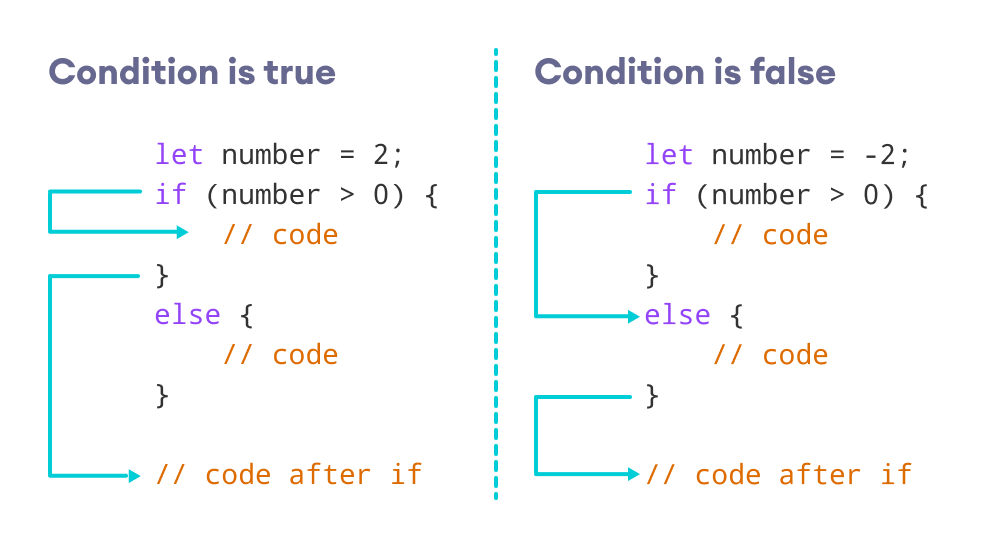
(JavaScript Tutorials for Beginners)
In this end-to-end example, you will learn – JavaScript tutorials for Beginners – JavaScript if…else Statement.
JavaScript if…else Statement
In this tutorial, you will learn about the if…else statement to create decision making programs with the help of examples.
In programming, there may arise a situation where you have to run a block of code among more than one alternatives. For example, assigning grades A, B or C based on marks obtained by a student.
In such situations, you can use the JavaScript if...else statement to create a program that can make decisions.
In JavaScript, there are three forms of the if...else statement.
- if statement
- if…else statement
- if…else if…else statement
JavaScript if Statement
The syntax of the if statement is:
if (condition) {
// the body of if
}The if statement evaluates the condition inside the parenthesis ().
- If the condition is evaluated to
true, the code inside the body ofifis executed. - If the condition is evaluated to
false, the code inside the body ofifis skipped.
Note: The code inside { } is the body of the if statement.

Example 1: if Statement
// check if the number is positive
let number = prompt("Enter a number: ");
// check if number is greater than 0
if (number > 0) {
// the body of the if statement
console.log("The number is positive");
}
console.log("The if statement is easy");Output 1
Enter a number: 2 The number is positive The if statement is easy
Suppose the user entered 2. In this case, the condition number > 0 evaluates to true. And, the body of the if statement is executed.
Output 2
Enter a number: -1 The if statement is easy
Suppose the user entered -1. In this case, the condition number > 0 evaluates to false. Hence, the body of the if statement is skipped.
Since console.log("The if statement is easy"); is outside the body of the if statement, it is always executed.
Comparison and logical operators are used in conditions. So to learn more about comparison and logical operators, you can visit JavaScript Comparison and Logical Operators.
JavaScript if…else statement
An if statement can have an optional else clause. The syntax of the if...else statement is:
if (condition) {
// block of code if condition is true
} else {
// block of code if condition is false
}The if..else statement evaluates the condition inside the parenthesis.
If the condition is evaluated to true,
- the code inside the body of
ifis executed - the code inside the body of
elseis skipped from execution
If the condition is evaluated to false,
- the code inside the body of
elseis executed - the code inside the body of
ifis skipped from execution

Example 2 : if…else Statement
// check is the number is positive or negative/zero
let number = prompt("Enter a number: ");
// check if number is greater than 0
if (number > 0) {
console.log("The number is positive");
}
// if number is not greater than 0
else {
console.log("The number is either a negative number or 0");
}
console.log("The if...else statement is easy");Output 1
Enter a number: 2 The number is positive The if...else statement is easy
Suppose the user entered 2. In this case, the condition number > 0 evaluates to true. Hence, the body of the if statement is executed and the body of the else statement is skipped.
Output 2
Enter a number: -1 The number is either a negative number or 0 The if...else statement is easy
Suppose the user entered -1. In this case, the condition number > 0 evaluates to false. Hence, the body of the else statement is executed and the body of the if statement is skipped.
JavaScript if…else if statement
The if...else statement is used to execute a block of code among two alternatives. However, if you need to make a choice between more than two alternatives, if...else if...else can be used.
The syntax of the if...else if...else statement is:
if (condition1) {
// code block 1
} else if (condition2){
// code block 2
} else {
// code block 3
}- If condition1 evaluates to
true, the code block 1 is executed. - If condition1 evaluates to
false, then condition2 is evaluated.- If the condition2 is
true, the code block 2 is executed. - If the condition2 is
false, the code block 3 is executed.
- If the condition2 is

Example 3: if…else if Statement
// check if the number if positive, negative or zero
let number = prompt("Enter a number: ");
// check if number is greater than 0
if (number > 0) {
console.log("The number is positive");
}
// check if number is 0
else if (number == 0) {
console.log("The number is 0");
}
// if number is neither greater than 0, nor zero
else {
console.log("The number is negative");
}
console.log("The if...else if...else statement is easy");Output
Enter a number: 0 The number is 0 The if...else if...else statement is easy
Suppose the user entered 0, then the first test condition number > 0 evaluates to false. Then, the second test condition number == 0 evaluates to true and its corresponding block is executed.
Nested if…else Statement
You can also use an if...else statement inside of an if...else statement. This is also known as nested if…else statement.
Example 4: Nested if…else Statement
// check if the number is positive, negative or zero
let number = prompt("Enter a number: ");
if (number >= 0) {
if (number == 0) {
console.log("You entered number 0");
} else {
console.log("You entered a positive number");
}
} else {
console.log("You entered a negative number");
}Output
Enter a number: 0 You entered number 0
Suppose the user entered 0. In this case, the condition number > -1 evaluates to true. Then the second condition number == 0 is checked which evaluates to true and its corresponding body is executed.
Note: As you can see, nested if...else makes your logic complicated. If possible, you should always try to avoid nested if...else.
Body of if…else With Only One Statement
If the body of if...else has only one statement, you can omit { } in the program. For example, you can replace
let number = 2;
if (number > 0) {
console.log("The number is positive.");
} else {
console.log("The number is negative or zero.");
}with
let number = 2;
if (number > 0)
console.log("The number is positive.");
else
console.log("The number is negative or zero.");The output of both programs will be the same.
Output
The number is positive.
Note: Although it’s not necessary to use { } if the body of if...else has only one statement, using { } makes your code more readable.
More on Decision Making
In certain situations, a ternary operator can replace an if...else statement. To learn more, visit JavaScript Ternary Operator.
If you need to make a choice between more than one alternatives based on a given test condition, the switch statement can be used. To learn more, visit JavaScript switch.
Disclaimer: The information and code presented within this recipe/tutorial is only for educational and coaching purposes for beginners and developers. Anyone can practice and apply the recipe/tutorial presented here, but the reader is taking full responsibility for his/her actions. The author (content curator) of this recipe (code / program) has made every effort to ensure the accuracy of the information was correct at time of publication. The author (content curator) does not assume and hereby disclaims any liability to any party for any loss, damage, or disruption caused by errors or omissions, whether such errors or omissions result from accident, negligence, or any other cause. The information presented here could also be found in public knowledge domains.
Learn by Coding: v-Tutorials on Applied Machine Learning and Data Science for Beginners
Latest end-to-end Learn by Coding Projects (Jupyter Notebooks) in Python and R:
All Notebooks in One Bundle: Data Science Recipes and Examples in Python & R.
End-to-End Python Machine Learning Recipes & Examples.
End-to-End R Machine Learning Recipes & Examples.
Applied Statistics with R for Beginners and Business Professionals
Data Science and Machine Learning Projects in Python: Tabular Data Analytics
Data Science and Machine Learning Projects in R: Tabular Data Analytics
Python Machine Learning & Data Science Recipes: Learn by Coding
R Machine Learning & Data Science Recipes: Learn by Coding
Comparing Different Machine Learning Algorithms in Python for Classification (FREE)
There are 2000+ End-to-End Python & R Notebooks are available to build Professional Portfolio as a Data Scientist and/or Machine Learning Specialist. All Notebooks are only $29.95. We would like to request you to have a look at the website for FREE the end-to-end notebooks, and then decide whether you would like to purchase or not.